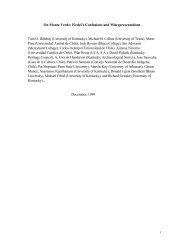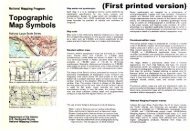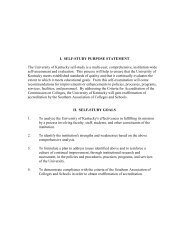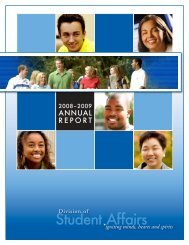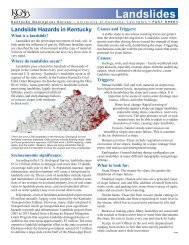Exercise of human agency through collective efficacy - Exordio
Exercise of human agency through collective efficacy - Exordio
Exercise of human agency through collective efficacy - Exordio
You also want an ePaper? Increase the reach of your titles
YUMPU automatically turns print PDFs into web optimized ePapers that Google loves.
CURRENT DIRECTIONS IN PSYCHOLOGICAL SCIENCE<br />
<strong>Exercise</strong> <strong>of</strong> Human Agency Through<br />
Collective Efficacy<br />
Albert Bandura 1<br />
Department <strong>of</strong> Psychology, Stanford University, Stanford, California<br />
Abstract<br />
Social cognitive theory<br />
adopts an agentic perspective<br />
in which individuals are producers<br />
<strong>of</strong> experiences and<br />
shapers <strong>of</strong> events. Among the<br />
mechanisms <strong>of</strong> <strong>human</strong> <strong>agency</strong>,<br />
none is more focal or pervading<br />
than the belief <strong>of</strong> personal<br />
<strong>efficacy</strong>. This core belief is the<br />
foundation <strong>of</strong> <strong>human</strong> <strong>agency</strong>.<br />
Unless people believe that they<br />
can produce desired effects<br />
and forestall undesired ones by<br />
their actions, they have little<br />
incentive to act. The growing<br />
interdependence <strong>of</strong> <strong>human</strong><br />
functioning is placing a premium<br />
on the exercise <strong>of</strong> <strong>collective</strong><br />
<strong>agency</strong> <strong>through</strong> shared beliefs<br />
in the power to produce<br />
effects by <strong>collective</strong> action. The<br />
present article analyzes the nature<br />
<strong>of</strong> perceived <strong>collective</strong> <strong>efficacy</strong><br />
and its centrality in how<br />
people live their lives. Perceived<br />
<strong>collective</strong> <strong>efficacy</strong> fosters<br />
groups’ motivational commitment<br />
to their missions,<br />
resilience to adversity, and<br />
performance accomplishments.<br />
Keywords<br />
<strong>collective</strong> <strong>agency</strong>; collectivismindividualism;<br />
emergent properties;<br />
interdependence; perceived<br />
self-<strong>efficacy</strong>; social<br />
cognitive theory<br />
People are partly the products <strong>of</strong><br />
their environments, but by selecting,<br />
creating, and transforming<br />
their environmental circumstances<br />
they are producers <strong>of</strong> environments<br />
as well. This agentic capability<br />
enables them to influence the<br />
course <strong>of</strong> events and to take a hand<br />
in shaping their lives. A substantial<br />
body <strong>of</strong> literature based on diverse<br />
lines <strong>of</strong> research in varied spheres<br />
<strong>of</strong> functioning shows that, indeed,<br />
people motivate and guide their actions<br />
partly by their beliefs <strong>of</strong> personal<br />
<strong>efficacy</strong> (Bandura, 1997).<br />
Perceived <strong>efficacy</strong> plays a key<br />
role in <strong>human</strong> functioning because<br />
it affects behavior not only directly,<br />
but by its impact on other determinants<br />
such as goals and aspirations,<br />
outcome expectations, affective<br />
proclivities, and perception <strong>of</strong><br />
impediments and opportunities in<br />
the social environment. Efficacy beliefs<br />
influence whether people<br />
think erratically or strategically,<br />
optimistically or pessimistically;<br />
what courses <strong>of</strong> action they choose<br />
to pursue; the goals they set for<br />
themselves and their commitment<br />
to them; how much effort they put<br />
forth in given endeavors; the outcomes<br />
they expect their efforts to<br />
produce; how long they persevere<br />
in the face <strong>of</strong> obstacles; their resilience<br />
to adversity; how much stress<br />
and depression they experience in<br />
coping with taxing environmental<br />
demands; and the accomplishments<br />
they realize. Statistical analyses<br />
that combine the findings <strong>of</strong><br />
numerous studies confirm the influential<br />
role <strong>of</strong> perceived self<strong>efficacy</strong><br />
in <strong>human</strong> adaptation and<br />
change.<br />
FORMS OF HUMAN<br />
AGENCY<br />
Conceptions <strong>of</strong> <strong>human</strong> <strong>agency</strong><br />
have been essentially confined to<br />
personal <strong>agency</strong> exercised individually.<br />
But this is not the only<br />
form <strong>of</strong> <strong>agency</strong> <strong>through</strong> which<br />
people manage events that affect<br />
their lives. Social-cognitive theory<br />
distinguishes among three different<br />
forms <strong>of</strong> <strong>agency</strong>—personal,<br />
proxy, and <strong>collective</strong>.<br />
The theorizing and research on<br />
<strong>human</strong> <strong>agency</strong> has centered almost<br />
exclusively on the direct exercise <strong>of</strong><br />
personal <strong>agency</strong> and the cognitive,<br />
motivational, affective, and choice<br />
processes <strong>through</strong> which it exerts<br />
its effects. In many activities, however,<br />
people do not have direct<br />
control over social conditions and<br />
institutional practices that affect<br />
their lives. Under these circumstances,<br />
they seek their well-being<br />
and security <strong>through</strong> the exercise<br />
<strong>of</strong> proxy <strong>agency</strong>. In this socially<br />
mediated mode <strong>of</strong> <strong>agency</strong>, people<br />
try to get other people who have<br />
expertise or wield influence and<br />
power to act on their behalf to get<br />
the outcomes they desire. People<br />
also turn to proxy control because<br />
they do not want to saddle themselves<br />
with the arduous work<br />
needed to develop requisite competencies,<br />
and to shoulder the responsibilities<br />
and stressors that the<br />
exercise <strong>of</strong> control entails. These<br />
dissuading conditions dull the appetite<br />
for personal control.<br />
People do not live their lives in<br />
individual autonomy. Indeed, many<br />
<strong>of</strong> the outcomes they seek are<br />
achievable only <strong>through</strong> interdependent<br />
efforts. Hence, they have<br />
to work together to secure what<br />
they cannot accomplish on their<br />
own. Social cognitive theory extends<br />
the conception <strong>of</strong> <strong>human</strong><br />
<strong>agency</strong> to <strong>collective</strong> <strong>agency</strong>. People’s<br />
shared beliefs in their <strong>collective</strong><br />
power to produce desired<br />
results are a key ingredient <strong>of</strong> <strong>collective</strong><br />
<strong>agency</strong>. A group’s attainments<br />
are the product not only <strong>of</strong><br />
shared knowledge and skills <strong>of</strong> its<br />
different members, but also <strong>of</strong> the<br />
interactive, coordinative, and synergistic<br />
dynamics <strong>of</strong> their transac-<br />
Copyright © 2000 American Psychological Society 75
76 VOLUME 9, NUMBER 3, JUNE 2000<br />
tions. For example, it is not uncommon<br />
for groups with members who<br />
are talented individually to perform<br />
poorly <strong>collective</strong>ly because<br />
the members cannot work well together<br />
as a unit. Therefore, perceived<br />
<strong>collective</strong> <strong>efficacy</strong> is not<br />
simply the sum <strong>of</strong> the <strong>efficacy</strong><br />
beliefs <strong>of</strong> individual members.<br />
Rather, it is an emergent grouplevel<br />
property.<br />
The locus <strong>of</strong> perceived <strong>collective</strong><br />
<strong>efficacy</strong> resides in the minds <strong>of</strong><br />
group members. A group, <strong>of</strong> course,<br />
operates <strong>through</strong> the behavior <strong>of</strong><br />
its members. It is people acting coordinatively<br />
on a shared belief, not<br />
a disembodied group mind that is<br />
doing the cognizing, aspiring, motivating,<br />
and regulating. There is<br />
no emergent entity that operates<br />
independently <strong>of</strong> the beliefs and<br />
actions <strong>of</strong> the individuals who<br />
make up a social system. Although<br />
beliefs <strong>of</strong> <strong>collective</strong> <strong>efficacy</strong> include<br />
emergent aspects, they serve functions<br />
similar to those <strong>of</strong> personal <strong>efficacy</strong><br />
beliefs and operate <strong>through</strong><br />
similar processes (Bandura, 1997).<br />
People’s shared beliefs in their <strong>collective</strong><br />
<strong>efficacy</strong> influence the types<br />
<strong>of</strong> futures they seek to achieve<br />
<strong>through</strong> <strong>collective</strong> action, how well<br />
they use their resources, how much<br />
effort they put into their group endeavor,<br />
their staying power when<br />
<strong>collective</strong> efforts fail to produce<br />
quick results or meet forcible opposition,<br />
and their vulnerability to the<br />
discouragement that can beset<br />
people taking on tough social problems.<br />
MEASURING COLLECTIVE<br />
EFFICACY<br />
There are two main approaches<br />
to the measurement <strong>of</strong> a group’s<br />
perceived <strong>efficacy</strong>. The first method<br />
aggregates the individual members’<br />
appraisals <strong>of</strong> their personal<br />
capabilities to execute the particular<br />
functions they perform in the<br />
group. The second method aggregates<br />
members’ appraisals <strong>of</strong> their<br />
group’s capability operating as a<br />
whole. The latter holistic appraisal<br />
encompasses the coordinative and<br />
interactive aspects operating within<br />
groups.<br />
One could also measure perceived<br />
<strong>collective</strong> <strong>efficacy</strong> by having<br />
group members arrive at a concordant<br />
judgment. The deliberative<br />
approach has serious limitations,<br />
however. Forming a consensual<br />
judgment <strong>of</strong> a group’s <strong>efficacy</strong> via<br />
group discussion is subject to<br />
the distorting vagaries <strong>of</strong> social<br />
persuasion by individuals who<br />
command power and by pressures<br />
for conformity. Assessment by<br />
constructed consensus may itself<br />
change the <strong>efficacy</strong> beliefs. Moreover,<br />
a social system is not a monolith.<br />
A forced consensus masks<br />
the variability in <strong>efficacy</strong> beliefs<br />
among factions within a system.<br />
The two informative indices <strong>of</strong><br />
perceived <strong>collective</strong> <strong>efficacy</strong> differ<br />
in the relative weight given to individual<br />
factors and interactive<br />
ones, but they are not as distinct as<br />
they might appear. Being socially<br />
situated, and <strong>of</strong>ten interdependently<br />
so, individuals’ judgments<br />
<strong>of</strong> their personal <strong>efficacy</strong> are not<br />
detached from the other members’<br />
enabling or impeding activities.<br />
For example, in judging personal<br />
<strong>efficacy</strong>, a football quarterback obviously<br />
considers the quality <strong>of</strong> his<br />
<strong>of</strong>fensive line, the fleetness and<br />
blocking capabilities <strong>of</strong> his running<br />
backs, the adeptness <strong>of</strong> his receivers,<br />
and how well they all work<br />
together as a unit. In short, a judgment<br />
<strong>of</strong> individual <strong>efficacy</strong> inevitably<br />
embodies the coordinative and<br />
interactive group dynamics. Conversely,<br />
in judging the <strong>efficacy</strong> <strong>of</strong><br />
their team, members certainly consider<br />
how well key teammates can<br />
execute their roles. Players on the<br />
Chicago basketball team would<br />
judge their team <strong>efficacy</strong> quite<br />
differently depending on whether<br />
or not Michael Jordan was in the<br />
lineup.<br />
Given the interdependent nature<br />
<strong>of</strong> the appraisal process, linking<br />
<strong>efficacy</strong> measured at the individual<br />
level to performance at the<br />
group level does not necessarily<br />
represent a cross-level relation. The<br />
two indices <strong>of</strong> <strong>collective</strong> <strong>efficacy</strong><br />
are at least moderately correlated<br />
and predictive <strong>of</strong> group performance.<br />
The fact that appraisals <strong>of</strong><br />
group <strong>efficacy</strong> embody members’<br />
dependence on one another has<br />
important bearing on gauging<br />
emergent properties. It is commonly<br />
assumed that an emergent<br />
property is operative if differences<br />
between groups remain after statistical<br />
methods are used to control<br />
variation in characteristics <strong>of</strong> individuals<br />
within the groups. The<br />
analytic logic is fine, but the results<br />
<strong>of</strong> such statistical controls can be<br />
quite misleading. Because judgments<br />
<strong>of</strong> personal <strong>efficacy</strong> take into<br />
consideration the unique dynamics<br />
<strong>of</strong> a group, individual-level controls<br />
can inadvertently remove<br />
most <strong>of</strong> the emergent group properties.<br />
The relative predictiveness <strong>of</strong><br />
the two indices <strong>of</strong> <strong>collective</strong> <strong>efficacy</strong><br />
will depend largely on the degree<br />
<strong>of</strong> interdependent effort<br />
needed to achieve desired results.<br />
For example, the accomplishments<br />
<strong>of</strong> a gymnastics team are the sum<br />
<strong>of</strong> successes achieved independently<br />
by the gymnasts, whereas<br />
the accomplishments <strong>of</strong> a soccer<br />
team are the product <strong>of</strong> players<br />
working intricately together. Any<br />
weak link, or a breakdown in a<br />
subsystem, can have ruinous effects<br />
on a soccer team despite an<br />
otherwise high level <strong>of</strong> talent. The<br />
aggregated holistic index is most<br />
suitable for performance outcomes<br />
achievable only by adept teamwork.<br />
Under low system interdependence,<br />
members may inspire,<br />
motivate, and support each other,<br />
Published by Blackwell Publishers Inc.
CURRENT DIRECTIONS IN PSYCHOLOGICAL SCIENCE<br />
77<br />
but the group outcome is the sum<br />
<strong>of</strong> the attainments produced individually<br />
rather than by the members<br />
working together. Aggregated<br />
personal efficacies are well suited<br />
to measure perceived <strong>efficacy</strong> for<br />
the latter types <strong>of</strong> endeavors.<br />
CONTENTIOUS DUALISMS<br />
Conceptualizations <strong>of</strong> group<br />
functioning are replete with contentious<br />
dualisms that social cognitive<br />
theory rejects. They include<br />
personal <strong>agency</strong> versus social<br />
structure, self-centered <strong>agency</strong> versus<br />
communality, and individualism<br />
versus collectivism. The<br />
<strong>agency</strong>-sociostructural duality pits<br />
psychological theories and sociostructural<br />
theories as rival conceptions<br />
<strong>of</strong> <strong>human</strong> behavior or as<br />
representing different levels and<br />
temporal proximity <strong>of</strong> influences.<br />
In the social cognitive theory <strong>of</strong> triadic<br />
reciprocal causation (Bandura,<br />
1986, 1997), personal <strong>agency</strong> and<br />
social structure operate interdependently.<br />
Social structures are<br />
created by <strong>human</strong> activity, and sociostructural<br />
practices, in turn, impose<br />
constraints and provide resources<br />
and opportunities for<br />
personal development and functioning.<br />
A full understanding <strong>of</strong> <strong>human</strong><br />
adaptation and change requires an<br />
integrative causal structure in<br />
which sociostructural influences<br />
operate <strong>through</strong> mechanisms <strong>of</strong> the<br />
self system to produce behavioral<br />
effects. However, in agentic transactions,<br />
the self system is not<br />
merely a conduit for external influences.<br />
The self is socially constituted<br />
but, by exercising selfinfluence,<br />
<strong>human</strong> <strong>agency</strong> operates<br />
generatively and proactively on social<br />
systems, not just reactively.<br />
Nor can sociostructural and psychological<br />
determinants be dichotomized<br />
neatly into remote and<br />
proximate ones. For example, poverty<br />
is not a matter <strong>of</strong> multilayered<br />
or remote causation. Lacking the<br />
money needed to provide for the<br />
subsistence <strong>of</strong> one’s family pervades<br />
everyday life in an immediate<br />
way. Analyses <strong>of</strong> paths <strong>of</strong><br />
influence involving educational,<br />
familial, occupational, and political<br />
spheres <strong>of</strong> functioning lend support<br />
for a multicausal model that<br />
integrates sociostructural and personal<br />
determinants. Economic conditions,<br />
socioeconomic status, and<br />
family structure affect behavior<br />
<strong>through</strong> their impact on people’s<br />
sense <strong>of</strong> <strong>efficacy</strong>, aspirations, and<br />
affective self-regulatory factors<br />
rather than directly.<br />
Another disputable duality pits<br />
self-<strong>efficacy</strong>, misconstrued as a<br />
self-centered individualism and<br />
selfishness, against communal attachments<br />
and civic responsibility.<br />
A sense <strong>of</strong> <strong>efficacy</strong> does not necessarily<br />
spawn an individualistic lifestyle,<br />
identity, or morality. If belief<br />
in the power to produce results is<br />
put to social purposes, it fosters a<br />
communal life rather than eroding<br />
it. Indeed, developmental studies<br />
show that a high sense <strong>of</strong> <strong>efficacy</strong><br />
promotes a prosocial orientation<br />
characterized by cooperativeness,<br />
helpfulness, and sharing.<br />
Another variant <strong>of</strong> dualism inappropriately<br />
equates self-<strong>efficacy</strong><br />
with individualism and pits it<br />
against collectivism at a cultural<br />
level. In fact, high perceived <strong>efficacy</strong><br />
is vital for successful functioning<br />
regardless <strong>of</strong> whether it is<br />
achieved individually or by group<br />
members working together. A <strong>collective</strong><br />
system with members<br />
plagued by self-doubts about their<br />
capabilities to perform their roles<br />
will achieve little. A strong sense <strong>of</strong><br />
personal <strong>efficacy</strong> to manage one’s<br />
life circumstances and to have a<br />
hand in effecting societal changes<br />
contributes substantially to perceived<br />
<strong>collective</strong> <strong>efficacy</strong> (Fernández-Ballesteros,<br />
Díez-Nicolás, Caprara,<br />
Barbaranelli, & Bandura,<br />
1999).<br />
Cross-cultural research attests to<br />
the general functional value <strong>of</strong> <strong>efficacy</strong><br />
beliefs. Perceived personal<br />
<strong>efficacy</strong> contributes to productive<br />
functioning by members <strong>of</strong> collectivistic<br />
cultures just as it contributes<br />
to functioning by people<br />
raised in individualistic cultures<br />
(Earley, 1994). But culture shapes<br />
how <strong>efficacy</strong> beliefs are developed,<br />
the purposes to which they are put,<br />
and the sociostructural arrangement<br />
under which they are best expressed.<br />
Cultures are not monolithic, static<br />
entities as stereotypic portrayals<br />
indicate. Both individualistic and<br />
collectivistic sociocultural systems<br />
come in a variety <strong>of</strong> forms. Moreover,<br />
there is substantial heterogeneity<br />
in communality among<br />
individuals in different cultural<br />
systems, and even greater intraindividual<br />
variation across different<br />
types <strong>of</strong> social relationships.<br />
IMPACT OF PERCEIVED<br />
COLLECTIVE EFFICACY<br />
ON GROUP FUNCTIONING<br />
A growing body <strong>of</strong> research attests<br />
to the impact <strong>of</strong> perceived <strong>collective</strong><br />
<strong>efficacy</strong> on group functioning.<br />
Some <strong>of</strong> these studies have<br />
assessed the motivational and behavioral<br />
effects <strong>of</strong> perceived <strong>collective</strong><br />
<strong>efficacy</strong> using experimental<br />
manipulations to instill differential<br />
levels <strong>of</strong> perceived <strong>efficacy</strong><br />
(Durham, Knight, & Locke, 1997;<br />
Earley, 1994; Hodges & Carron,<br />
1992; Prussia & Kinicki, 1996).<br />
Other investigations have examined<br />
the effects <strong>of</strong> naturally developed<br />
beliefs <strong>of</strong> <strong>collective</strong> <strong>efficacy</strong>.<br />
The latter studies have analyzed<br />
diverse social systems, including<br />
educational systems (Bandura,<br />
1997), business organizations (Earley,<br />
1994; Hodges & Carron, 1992;<br />
Little & Madigan, 1994), athletic<br />
Copyright © 2000 American Psychological Society
78 VOLUME 9, NUMBER 3, JUNE 2000<br />
teams (Carron, 1984; Feltz & Lirgg,<br />
1998; Mullen & Cooper, 1994;<br />
Spink, 1990), combat teams (Jex &<br />
Bliese, 1999; Lindsley, Mathieu,<br />
Heffner, & Brass, 1994), and urban<br />
neighborhoods (Sampson, Raudenbush,<br />
& Earls, 1997). The findings<br />
taken as a whole show that the<br />
higher the perceived <strong>collective</strong> <strong>efficacy</strong>,<br />
the higher the groups’ motivational<br />
investment in their undertakings,<br />
the stronger their staying<br />
power in the face <strong>of</strong> impediments<br />
and setbacks, and the greater their<br />
performance accomplishments.<br />
The conjoint influence <strong>of</strong> perceived<br />
<strong>collective</strong> political <strong>efficacy</strong><br />
and trust in the governmental system<br />
predicts the form and level <strong>of</strong><br />
people’s political activity (Bandura,<br />
1997). People who believe they can<br />
achieve desired changes <strong>through</strong><br />
their <strong>collective</strong> voice, and who<br />
view their governmental systems<br />
as trustworthy, are active participants<br />
in conventional political activities.<br />
Those who believe they can<br />
accomplish social changes by perseverant<br />
<strong>collective</strong> action, but view<br />
the governing systems and <strong>of</strong>ficeholders<br />
as untrustworthy, favor<br />
more confrontive and coercive tactics<br />
outside the traditional political<br />
channels. The politically apathetic<br />
have little faith that they can influence<br />
governmental functioning<br />
<strong>through</strong> <strong>collective</strong> initiatives, and<br />
are disaffected from the political<br />
system, believing it ignores their<br />
interests.<br />
CONCLUDING REMARKS<br />
Significant progress has been<br />
made in understanding the nature,<br />
structure, and functions <strong>of</strong> perceived<br />
<strong>collective</strong> <strong>efficacy</strong>. However,<br />
much work remains to be<br />
done in evaluating the different<br />
ways <strong>of</strong> gauging <strong>collective</strong> <strong>efficacy</strong>,<br />
refining analytic procedures for<br />
identifying emergent properties<br />
arising from the social dynamics <strong>of</strong><br />
whole systems, and developing socially<br />
oriented strategies for enhancing<br />
<strong>collective</strong> <strong>efficacy</strong> to improve<br />
the quality <strong>of</strong> life and shape<br />
the social future.<br />
The revolutionary advances in<br />
electronic technologies and economic<br />
globalization have transformed<br />
the nature, reach, and loci<br />
<strong>of</strong> <strong>human</strong> influence, and the way<br />
people live their lives. These new<br />
social realities vastly expand opportunities<br />
and create new constraints,<br />
<strong>of</strong>ten by social forces that<br />
know no national borders. People’s<br />
success in shaping their social and<br />
economic lives lies partly in a<br />
shared sense <strong>of</strong> <strong>efficacy</strong> to bring<br />
their <strong>collective</strong> influence to bear on<br />
matters over which they can have<br />
some command. With growing international<br />
embeddedness and interdependence<br />
<strong>of</strong> societies, the<br />
scope <strong>of</strong> cross-cultural research<br />
must be broadened to elucidate<br />
how global forces from abroad interact<br />
with national ones to shape<br />
the nature <strong>of</strong> cultural life. As globalization<br />
reaches ever deeper into<br />
people’s lives, a resilient sense <strong>of</strong><br />
shared <strong>efficacy</strong> becomes critical to<br />
furthering their common interests.<br />
Recommended Reading<br />
Bandura, A. (1995). Self-<strong>efficacy</strong> in<br />
changing societies. New York:<br />
Cambridge University Press.<br />
Bandura, A. (1997). (See References)<br />
Bandura, A. (1999). A social cognitive<br />
theory <strong>of</strong> personality. In L.<br />
Pervin & O. John (Eds.), Handbook<br />
<strong>of</strong> personality (2nd ed., pp. 154–<br />
196). New York: Guilford Publications.<br />
Maddux, J.E. (1995). Self-<strong>efficacy</strong>, adaptation,<br />
and adjustment: Theory,<br />
research, and application. New<br />
York: Plenum Press.<br />
Schwarzer, R. (1992). Self-<strong>efficacy</strong>:<br />
Thought control <strong>of</strong> action. Washington,<br />
DC: Hemisphere.<br />
Stajkovic, A.D., & Luthans, F. (1998).<br />
Self-<strong>efficacy</strong> and work related<br />
performance: A meta-analysis.<br />
Psychological Bulletin, 124, 240–<br />
261.<br />
Acknowledgments—Preparation <strong>of</strong> this<br />
article and some <strong>of</strong> the cited research<br />
were facilitated by grants from the Grant<br />
Foundation, Spencer Foundation, and Jacobs<br />
Foundation.<br />
Note<br />
1. Address correspondence to Albert<br />
Bandura, Department <strong>of</strong> Psychology,<br />
Stanford University, Stanford, CA<br />
94305-2130; e-mail: bandura@psych.<br />
stanford.edu.<br />
References<br />
Bandura, A. (1986). Social foundations <strong>of</strong> thought and<br />
action: A social cognitive theory. Englewood<br />
Cliffs, NJ: Prentice-Hall.<br />
Bandura, A. (1997). Self-<strong>efficacy</strong>: The exercise <strong>of</strong> control.<br />
New York: Freeman.<br />
Carron, A.V. (1984). Cohesion in sport teams. In<br />
J.M. Silva, III, & R.S. Weinberg (Eds.), Psychological<br />
foundations <strong>of</strong> sport (pp. 340–351). Champaign,<br />
IL: Human Kinetics Publications.<br />
Durham, C.C., Knight, D., & Locke, E.A. (1997).<br />
Effects <strong>of</strong> leader role, team-set goal difficulty,<br />
<strong>efficacy</strong>, and tactics on team effectiveness. Organizational<br />
Behavior and Human Decision Processes,<br />
72, 203–231.<br />
Earley, P.C. (1994). Self or group? Cultural effects<br />
<strong>of</strong> training on self-<strong>efficacy</strong> and performance.<br />
Administrative Science Quarterly, 39, 89–117.<br />
Feltz, D.L., & Lirgg, C.D. (1998). Perceived team<br />
and player <strong>efficacy</strong> in hockey. Journal <strong>of</strong> Applied<br />
Psychology, 83, 557–564.<br />
Fernández-Ballesteros, R., Díez-Nicolás, J., Caprara,<br />
G.V., Barbaranelli, C., & Bandura, A.<br />
(1999). Structural relation <strong>of</strong> perceived personal<br />
<strong>efficacy</strong> to perceived <strong>collective</strong> <strong>efficacy</strong>. Manuscript<br />
submitted for publication.<br />
Hodges, L., & Carron, A.V. (1992). Collective <strong>efficacy</strong><br />
and group performance. International<br />
Journal <strong>of</strong> Sport Psychology, 23, 48–59.<br />
Jex, S.M., & Bliese, P.D. (1999). Efficacy beliefs as a<br />
moderator <strong>of</strong> the impact <strong>of</strong> work-related<br />
stressors: A multilevel study. Journal <strong>of</strong> Applied<br />
Psychology, 84, 349–361.<br />
Lindsley, D.H., Mathieu, J.E., Heffner, T.S., &<br />
Brass, D.J. (1994, April). Team <strong>efficacy</strong>, potency,<br />
and performance: A longitudinal examination <strong>of</strong><br />
reciprocal processes. Paper presented at the annual<br />
meeting <strong>of</strong> the Society <strong>of</strong> Industrial-<br />
Organizational Psychology, Nashville, TN.<br />
Little, B.L., & Madigan, R.M. (1994, August). Motivation<br />
in work teams: A test <strong>of</strong> the construct <strong>of</strong><br />
<strong>collective</strong> <strong>efficacy</strong>. Paper presented at the annual<br />
meeting <strong>of</strong> the Academy <strong>of</strong> Management,<br />
Houston, TX.<br />
Mullen, B., & Cooper, C. (1994). The relation between<br />
group cohesiveness and performance:<br />
An integration. Psychological Bulletin, 115, 210–<br />
227.<br />
Prussia, G.E., & Kinicki, A.J. (1996). A motivational<br />
investigation <strong>of</strong> group effectiveness using<br />
social cognitive theory. Journal <strong>of</strong> Applied<br />
Psychology, 81, 187–198.<br />
Sampson, R.J., Raudenbush, S.W., & Earls, F.<br />
(1997). Neighborhoods and violent crime: A<br />
multilevel study <strong>of</strong> <strong>collective</strong> <strong>efficacy</strong>. Science,<br />
277, 918–924.<br />
Spink, K.S. (1990). Group cohesion and <strong>collective</strong><br />
<strong>efficacy</strong> <strong>of</strong> volleyball teams. Journal <strong>of</strong> Sport <strong>Exercise</strong><br />
Psychology, 12, 301–311.<br />
Published by Blackwell Publishers Inc.








